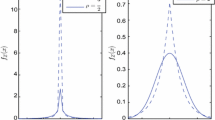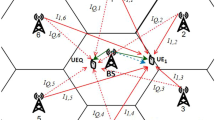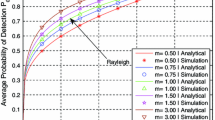Abstract
In this paper we consider a multiple-access scheme in which different users share the same bandwidth and the same pulse, and are discriminated at the receiver on the basis of the received energy using successive decoding. More specifically, we extend the performance analysis from the case of additive white Gaussian noise channels (presented in a previous work Salvo Rossi in Wirel Pers Commun, in press) to the case of fading channels. The presence of channel coefficients introduces a new degree of freedom in the transceiver design: unlike the AWGN case, different ordering among the users provides different transmitted energy, thus different overall system performance. Optimal ordering, in terms of minimum transmitted energy, is derived analytically. Analytical and numerical results, in terms of bit error rate and normalized throughput, are derived for performance evaluation in fading environments with optimal ordering exhibiting significant gains w.r.t. static ordering.
Similar content being viewed by others
References
Verdú S. (1998) Multiuser detection. Cambridge University Press, Cambridge
Aulin, T. M., & Espineira, R. (1999). Trellis coded multiple access (TCMA). In Proceedings of the IEEE international conference on communications (ICC) (pp. 1177–1181). June 1999.
Brannstrom, F. N., Aulin, T. M., & Rasmussen, L. K. (2001). Constellation-constrained capacity for trellis code multiple access systems. In Proceedings of the IEEE global telecommunications conference (GLOBECOM) (Vol. 2, pp. 791–795).
Brannstrom F. N., Aulin T. M., Rasmussen L. K. (2002) Iterative detectors for trellis-code multiple-access. IEEE Transactions on Communications 50(9): 1478–1485
Zhang W., D’Amours C., Yongacoglu A. (2004) Trellis coded modulation design for multi-user systems on AWGN channels. IEEE Vehicular Technology Conference (VTC) 3: 1722–1726
Guess T., Varanasi M. K. (2000) Signal design for bandwidth-efficient multiple-access communications based on eigenvalue optimization. IEEE Transactions on Information Theory 46(6): 2045–2058
Varanasi M. K., Guess T. (2001) Bandwidth-efficient multiple access (BEMA): A new strategy based on signal design under quality-of-service constraints for successive-decoding-type multiuser receivers. IEEE Transactions on Communications 49(5): 844–854
Viswanath P., Anantharam V., Tse D. N. C. (1999) Optimal sequences, power control, and user capacity of synchronous CDMA systems with linear MMSE multiuser receivers. IEEE Transactions on Information Theory 45(6): 1968–1983
Guess T., Varanasi M. K. (2003) A comparison of bandwidth-efficient multiple access to other signal designs for correlated waveform multiple-access communications. IEEE Transactions on Information Theory 49(6): 1558–1564
Wang X., Wu Y., Chouinard J. I., Wu H. C. (2006) On the design and performance analysis of multisymbol encapsulated OFDM systems. IEEE Transactions on Vehicular Technology 55(3): 990–1002
Singh, P., Chakrabarti, S., & Rajakumar, R. V. (2009). A novel multiple access scheme using MSE-OFDM for uplink. In Proceedings of the UK-India international workshop on cognitive wireless systems (UKIWCWS) (pp. 1–5). December 2009.
Singh, P., & Chakrabarti, S. (2010). A bandwidth efficient multiple access scheme using MSE-OFDM. In Proceedings of the IEEE international symposium on wireless pervasive computing (ISWPC) (pp. 386–389). May 2010.
Salvo Rossi, P., Romano, G., & Palmieri, F. (in press). On the performance of energy-division multiple access with regular constellations. Wireless Personal Communications, Springer.
Romano, G., Palmieri, F., Willett, P. K., & Mattera, D. (2005). Separability and gain control for overloaded CDMA. In Proceedings of the conference on information sciences and systems (CISS) (pp. 1–6). March 2005.
Romano, G., Ciuonzo, D., Palmieri, F., & Salvo Rossi, P. (2007). Group gain design for overloaded CDMA. In Proceedings of the IEEE international workshop on signal processing advances in wireless communications (SPAWC) (pp. 1–5). June 2007.
Steele R., Hanzo L. (1999) Mobile radio communications (2nd ed.). Wiley, West Sussex
Chiani M., Dardari D., Simon M. K. (2003) New exponential bounds and approximations for the computation of error probability in fading channels. IEEE Transactions on Wireless Communications 2(4): 840–845
David H. A., Nagaraja H. N. (2003) Order statistics. Wiley, London
Gradshteyn, I. S., & Ryzhik, I. M. (1994). Definite integrals of elementary functions. In A. Jeffrey (Ed.), Table of integrals, series, and products (Chapters 3, 4). London: Academic Press.
Rappaport T. F. (2002) Wireless communications: Principles and practice. Prentice Hall, Englewood Cliffs, NJ
Stamoulis A., Al-Dhahir N. (2003) Impact of space-time block codes on 802.11 network throughput. IEEE Transactions on Wireless Communications 2(5): 1029–1039
Author information
Authors and Affiliations
Corresponding author
Rights and permissions
About this article
Cite this article
Salvo Rossi, P., Ciuonzo, D., Romano, G. et al. On the Performance of Energy-Division Multiple Access Over Fading Channels. Wireless Pers Commun 68, 1351–1364 (2013). https://doi.org/10.1007/s11277-012-0511-z
Published:
Issue Date:
DOI: https://doi.org/10.1007/s11277-012-0511-z




